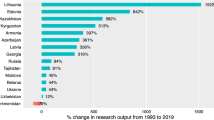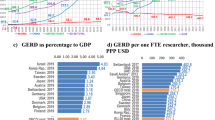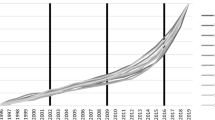Abstract
This paper examines the contribution of Indian universities to the mainstream scientific literature during 1987–1989 along two distinct, but inter-related dimensions of quantity and quality of research output. The quantity of output is assessed through the number of articles published in journals covered byScience Citation Index, while the quality of output is assessed through the impact factors of journals in which the articles are published. The impact factors are normalized to eliminate the confounding effects of their covariates,viz. the subject field and the nature of journal. A number of relative indicators are constructed for inter-field and inter-institution comparisons,viz. publication effectiveness index,1 relative quality index,2 activity index3 and citability index4. Inter-field comparisons are made at the level of eight macrofields: Mathematics, Physics, Chemistry, Biology, Earth & Space Sciences, Agriculture, Medical Sciences and Engineering & Technology. Inter-institution comparisons cover thirty three institutions which had published at least 150 articles in three years. The structure of correlations of these institutions with eight macrofields is analyzed through correspondence analysis of the matrices of activity and citability profiles. Correspondence analysis yields a mapping of institutions which reveals the structure of science as determined by the cumulative effect of resource allocation decisions taken in the past for different fields and institutions i.e. the effect of national science policy.
Similar content being viewed by others
Notes and references
P. S. Nagpaul, Neeraj Pant, Cross-national assessment of specialization patterns in Chemistry,Scientometrics, 27 (1993) 215–235.
P. S. Nagpaul,Scientometric Profile of Academic Science in India, National Institute of Science, Technology and Development Studies, New Delhi, 1992.
A. Schubert, T. Braun, Relative indicators and relational charts for comparative assessment of publication output and citation impact,Scientometrics, 9 (1986) 281–291.
P. S. Nagpaul,op. cit. 2..
S. Kumar, S. R. Das, Y. P. Sehgal, S. N. Gandhi, I. M. L. Ahuja, A. Wahid, N. P. Srivastava,Outturn of Scientific and Technical Manpower in India 1984–89, Human Resource Development Group, Council of Scientific & Industrial Research, New Delhi, 1993; All universities do not have faculties of science, engineering, medicine or agriculture.
A. Jain, S. Pruthi,Science and Technology Indicators, Segment Publishers, New Delhi (under publication).
P. S. Nagpaul,op. cit. 2..
E. de Weert, A macro-analysis of quality assessment in higher education,Higher Education, 19 (1990) 57–72.
R. M. Pirsig,Zen and the Art of Motor Cycle Maintenance, Corgi-books, 1974.
M. J. Moravcsik, Measures of scientific growth,Research Policy, 2 (1973) 266–275.
F. Narin,Evaluative Bibliometrics: The Use of Publications and Citations Analysis in the Evaluation of Scientific Activity, Computer-Horizons Inc., New Jersey, 1976.
E. Garfield, Citation analysis as a tool in journal evaluation,Science, 178 (1972) 471–479.
Several researchers have used impact factor as a surrogate measure of quality; see for example:M. P. Carpenter, F. Gibb, M. Harris, J. Irvine, B. R. Martin, F. Narin, Bibliometric Profile for British Academic Institutions: An experiment to develop research output indicators,Scientometrics, 14 (1988) 213–233;P. S. Nagpaul,op. cit. 2.Scientometric Profile of Academic Science in India, National Institute of Science, Technology and Development Studies, New Delhi, 1992.
The methodology of creating the database and its characteristics are described inP. S. Nagpaul,op. cit., 2..
B. K. Sen, K. Shailendra, Evaluation of scientific research output by bibliometric method,Scientometrics, 21 (1992) 31–46;P. S. Nagpaul,op. cit., 2.Scientometric Profile of Academic Science in India, National Institute of Science, Technology and Development Studies, New Delhi, 1992.
J. D. Frame, Mainstream research in Latin America and Caribbean,Interciencia, 2 (1977) 143–148.
A. Schubert, T. Braun,op. cit. 3..
M. P. Carpenter, F. Gibbs, M. Harris, J. Irvine, B. R. Martin, F. Narin,op. cit. 14..
P. S. Nagpaul, N. Pant,op. cit. 1..
P. S. Nagpaul,op. cit. 2. ;A. Schubert, T. Braun,op. cit. 3. Relative indicators and relational charts for comparative assessment of publication output and citation impact,Scientometrics, 9 (1986) 281–291.
See for example,L. Lebart, A. Morineau, K. M. Warwick,Multivariate Descriptive Statistical Analysis, John Wiley and Sons, New York, 1984.
Fmatch is a module of the computer program ‘Multidimensional Statistics Package’ (PC-MDS) developed byS. M. Smith, Institute of Business Management, Brigham Young University, Provho, Utah, USA.
N. Cliff, Orthogonal rotation to congurence,Psychometrika, 31 (1966) 33–42.
Author information
Authors and Affiliations
Rights and permissions
About this article
Cite this article
Nagpaul, P.S. Contribution of Indian universities to the mainstream scientific literature: A bibliometric assessment. Scientometrics 32, 11–36 (1995). https://doi.org/10.1007/BF02020186
Received:
Issue Date:
DOI: https://doi.org/10.1007/BF02020186




